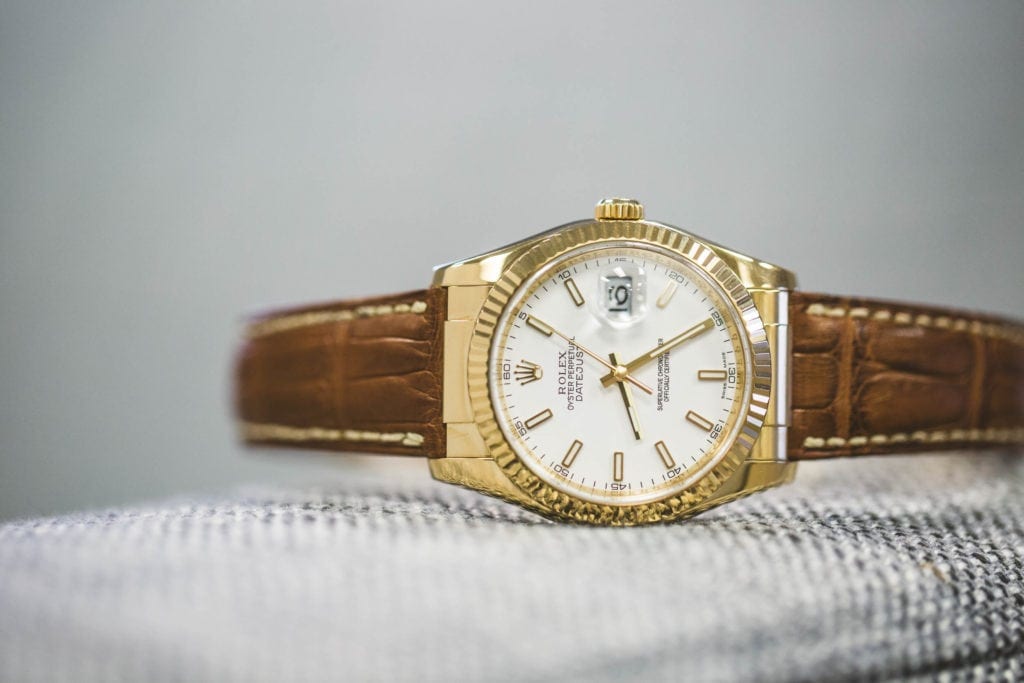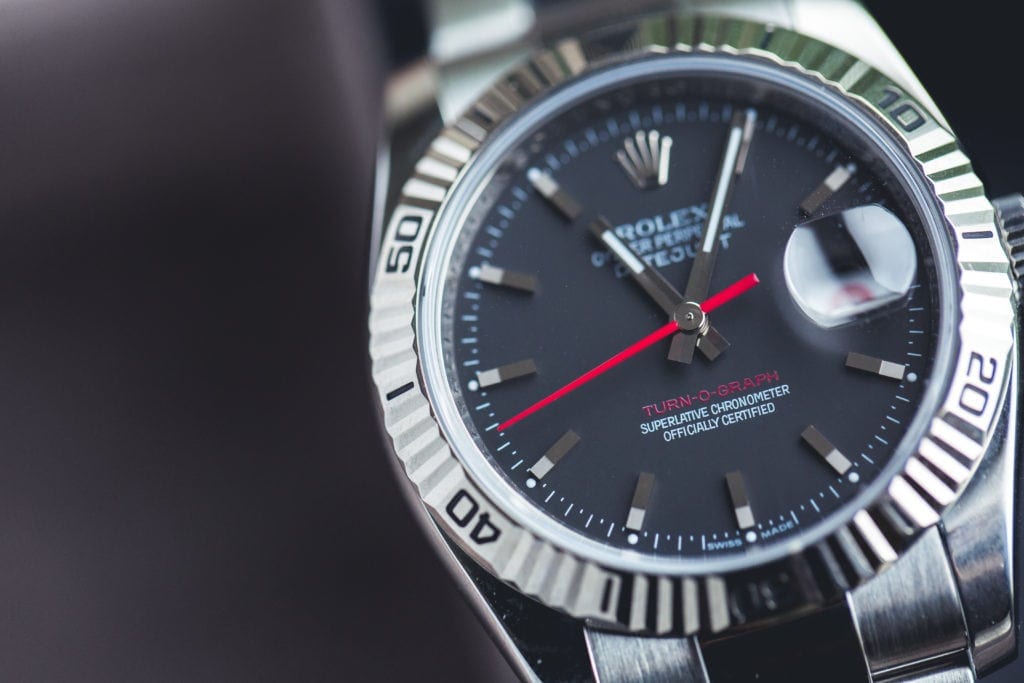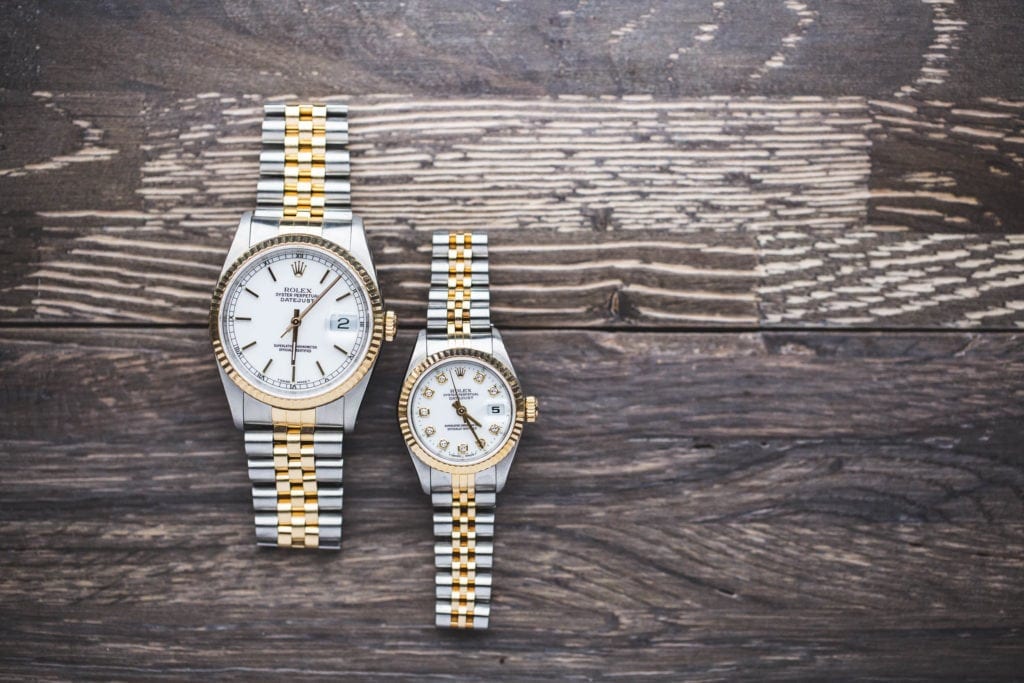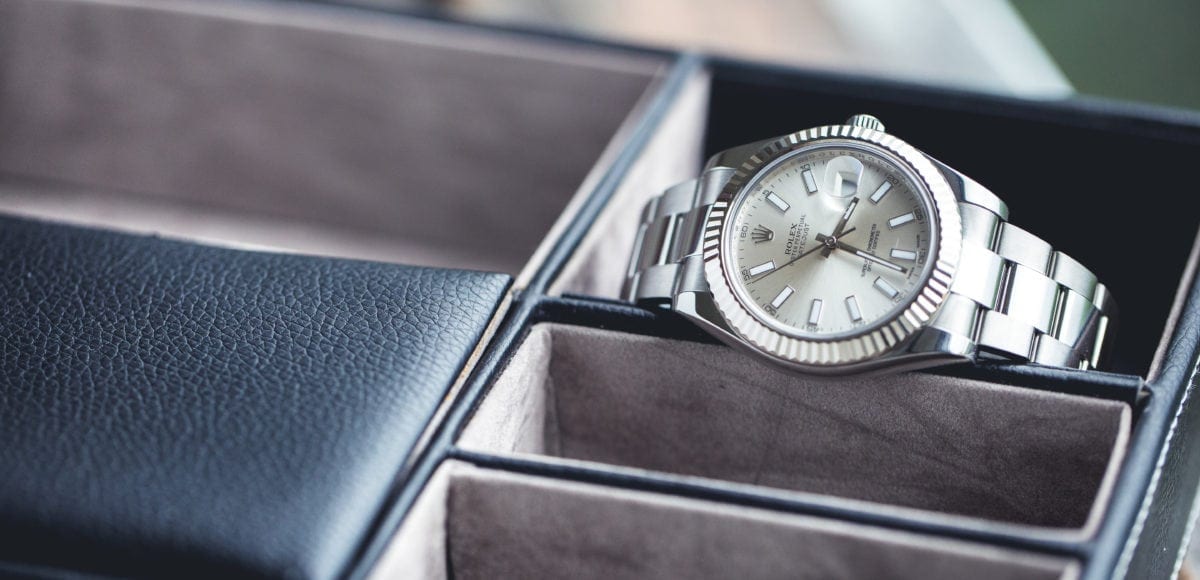The History of the Rolex Datejust
In 1945, Rolex celebrated a monumental occasion. To commemorate the milestone, they wanted to create a timepiece that was different from any other watch offered at the time. The result was the first self-winding, water resistant wristwatch with a date window on the dial. For their 40th anniversary, Rolex created the Datejust, which quickly became an iconic model. Take a look at the Rolex Datejust history and the model’s many firsts.
The Beginnings of the Datejust

The Rolex Datejust history begins with the Jubilee Datejust, Reference 4467. Its name comes from the brand’s all-new, five-piece metal link Jubilee bracelet, which has since become a staple for Rolex. The initial reference was only available in 18-karat gold and measured 36mm. In addition, it showcased the brand’s signature water resistant Oyster case with a fluted bezel. To accommodate the larger Caliber 710 movement that powered the new date function, the model featured a domed caseback, similar to the brand’s Bubbleback. Soon, the Datejust became the flagship model for Rolex.
Rolex Datejusts History of the Early 1950’s
The Datejust remained largely unchanged for its first ten years of production. Then, just about a decade after its initial release, the model received its first major aesthetic update. In 1954, Rolex debuted their all-new Cyclops lens on the Datejust. This magnifying lens sits directly above the date window, which increases the legibility by two and a half times. Since then, the Cyclops lens has become standard on Rolex models, from the Sky-Dweller to Submariner and GMT to Yacht-Master. A year later in 1955, Rolex launched a special edition variation of the model called the Turn-O-Graph. Later, United States Air Force pilots received this unique version as a reward when returning home from combat missions. It went on to garner the nickname the Thunderbird. What distinguished it from the other models was the rotating Turn-o-Graph bezel for which the watch gets its name.

Datejusts of the Late 1950’s
Rolex made another significant update to the Datejust a few years later in 1957. This modification was more technical than aesthetic. However, the functional change necessitated a small design update. The model received its first major upgrade with the addition of the Caliber 1065 movement. This smaller, more efficient caliber in turn altered the design of the Datejust. It eliminated the need for the domed caseback and created a more streamlined design for the model. In the late 1950s, Rolex also added a ladies’ variation to the Datejust collection. The design of the Lady Datejust is nearly identical to the men’s counterpart. The primary difference is in the size, with the ladies’ version measuring smaller than the men’s.

Rolex Datejusts of the 1960’s and 1970’s
The Rolex Datejust history continues with updates to its movement throughout the 1960s and 1970s. In 1965, Rolex introduced the famous Caliber 1570 into the model. Then, in the 1970s, the brand added the quickset feature to the timepiece. In turn, it got an all-new movement: the Caliber 3035. The introduction of the Caliber 3035 in 1977 with the Rolex 16014 gave the model a higher frequency. It boasted over 28,000 beats per hour as opposed to roughly 20,000 beats per hour. The result is significantly greater accuracy. Later in the 1970s, following the onset of the Quartz Crisis, Rolex introduced a quartz movement into the collection with the Datejust OysterQuartz, Reference 17000.
Rolex Refinements of The 1980’s
In the late 80s, Rolex changed the movement again to the Caliber 3135. This movement was approximately the same dimensions as the 3035. However, the addition of a sapphire crystal, replacing the acrylic, allowed for a slightly slimmer watch. This further refined the iconic design
The Modern Datejust

Today, the Datejust continues to be one of the brand’s most popular and highly sought after models. It’s available in three different metal options, including stainless steel as well as two-tone and yellow gold. Over the years, there have been four different bezel options for the Datejust. The model is currently available with a smooth or gem-set bezel. In addition, there’s the option for a fluted bezel in the 18-karat gold variation. Previously, Rolex offered an engine turned bezel for the Datejust. However, the brand discontinued this style in the early 2000s. In addition, there are just two bracelet choices for the Datejust: the original, dressier Jubilee and the sportier Oyster.
Last but not least is the dial. The Datejust is available with countless colors, types of hour markers, and materials to fit any style. Overall, the dial combination can have the greatest impact on the look and feel of the watch. For instance, a model with a darker dial and stick indices will appear smaller and have a more conservative style. On the other hand, a model with a white dial and Roman numeral markers has a bolder, more noticeable presence. In addition to these style choices, there’s the more functional option for luminescence on the indices and hands.
Introduction of the Datejust II
Nearly 65 years after the brand debuted the now-iconic Datejust, they gave it a facelift and unveiled the Datejust II. The second coming of the Datejust brought some modern upgrades. However, it still draws inspiration from the classic model that started the flagship collection.
The initial variation of the Datejust II first launched in 2009. Ultimately, it helped to bring the collection into the modern era. The design was sportier than the original Datejust. It featured an Oyster bracelet and lume on the dial for increased legibility. It also showcased a larger size, upgrading from the standard 36mm of the Datejust to a more contemporary 41mm.
In addition, the Datejust II debuted a few new features. First, it showcased the brand’s Twinlock Winding Crown. When paired with the iconic Oyster case, it increased the water resistance to 100 meters. The most notable upgrade for the Datejust II was the new in-house Caliber 3136 movement. It features Rolex’s patented Parachrom hairspring and Paraflex shock absorbers and boasts COSC certification.
A New Era: The Datejust 41
In 2016, Rolex threw fans of the Datejust a bit of a curve ball. They retired the Datejust II and launched the Datejust 41. As the name suggest, the Datejust 41 is a 41mm variation of the classic Datejust, much like the Datejust II. The biggest difference between the latest Datejust 41 and the Datejust II is, once again, the movement. Inside the Datejust 41 you’ll find the Rolex Caliber 3235 in-house movement, boasting fourteen patented parts and Superlative Chronometer certification.
Choosing the Best Datejust for You
At a glance, the Datejust and Datejust II are actually quite similar in appearance. Yet, once you start to dissect them, you’ll notice the differences. First, there’s the size. The Datejust is a traditionally smaller model measuring 36mm, whereas the Datejust II is slightly larger at 41mm. This not only influences the way they wear on the wrist but also impacts the proportions of the design. The Datejust II has a wider bezel and thicker lugs. In addition, it features more space between the date window, hour markers, and iconic Rolex crown at the twelve-o’clock position.
Then, you have to look under the hood. Both models come equipped with a COSC certified chronometer movement featuring Rolex’s patented Parachrom hairspring. However, the Datejust II’s Caliber 3136 also features the brand’s high-performance Paraflex shock absorbers. So, how to you choose between the classic Datejust, Datejust II, and all-new Datejust 41?
Today, the Datejust II is only available in the pre-owned market. If you’re looking for a new model, this might not be the right choice for you. On the other hand, if you want a rarer model that’s no longer in production, the Datejust II is a great option. Then, it comes down to size. If you prefer larger and more modern proportions, the Datejust 41 or Datejust II are both handsome watches. However, if you’re looking for a more modest size, go with the straightforward Datejust. For watch nerds, there’s always the movement to consider as well.
Get More Articles Like This in Your Inbox
We're constantly creating great content like this. So, why not get it delivered directly to your inbox? By subscribing you agree to our Privacy Policy but you can unsubscribe at any time.







Pingback:The Ultimate Rolex Datejust History Guide - Satisfying Suits | October 2, 2023
|